The Need for a Shift to Renewable Energy
VerifiedAdded on 2022/12/15
|10
|2565
|271
AI Summary
This article discusses the need for a shift to renewable energy sources and how the international community and multinational corporations are driving this transition. It explores the benefits of renewable energy, such as sustainability and reduced greenhouse gas emissions, and highlights the efforts of companies like Walmart and Tesla in embracing green energy. The article also addresses the challenges and technological advancements in renewable energy production.
Contribute Materials
Your contribution can guide someone’s learning journey. Share your
documents today.
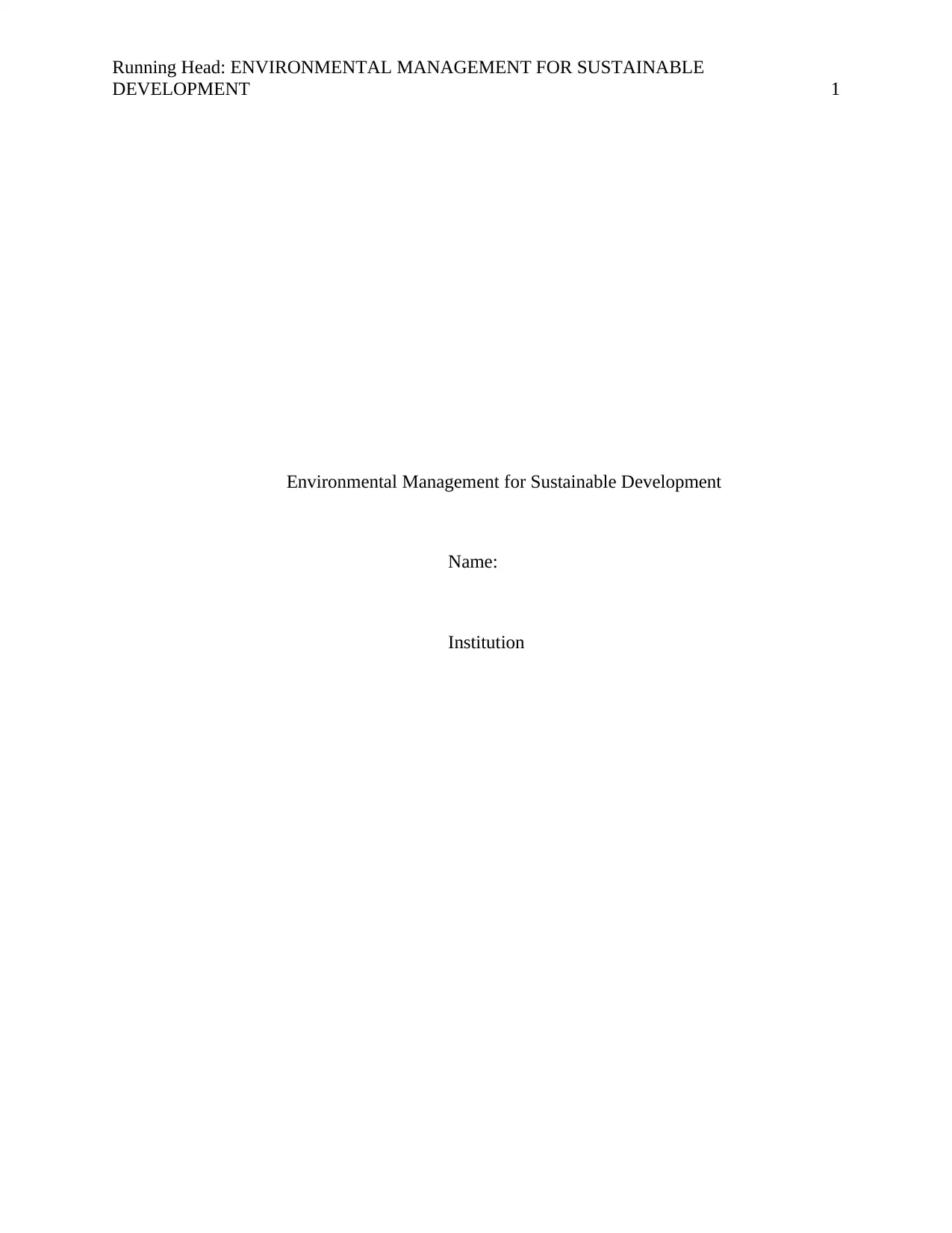
Running Head: ENVIRONMENTAL MANAGEMENT FOR SUSTAINABLE
DEVELOPMENT 1
Environmental Management for Sustainable Development
Name:
Institution
DEVELOPMENT 1
Environmental Management for Sustainable Development
Name:
Institution
Secure Best Marks with AI Grader
Need help grading? Try our AI Grader for instant feedback on your assignments.
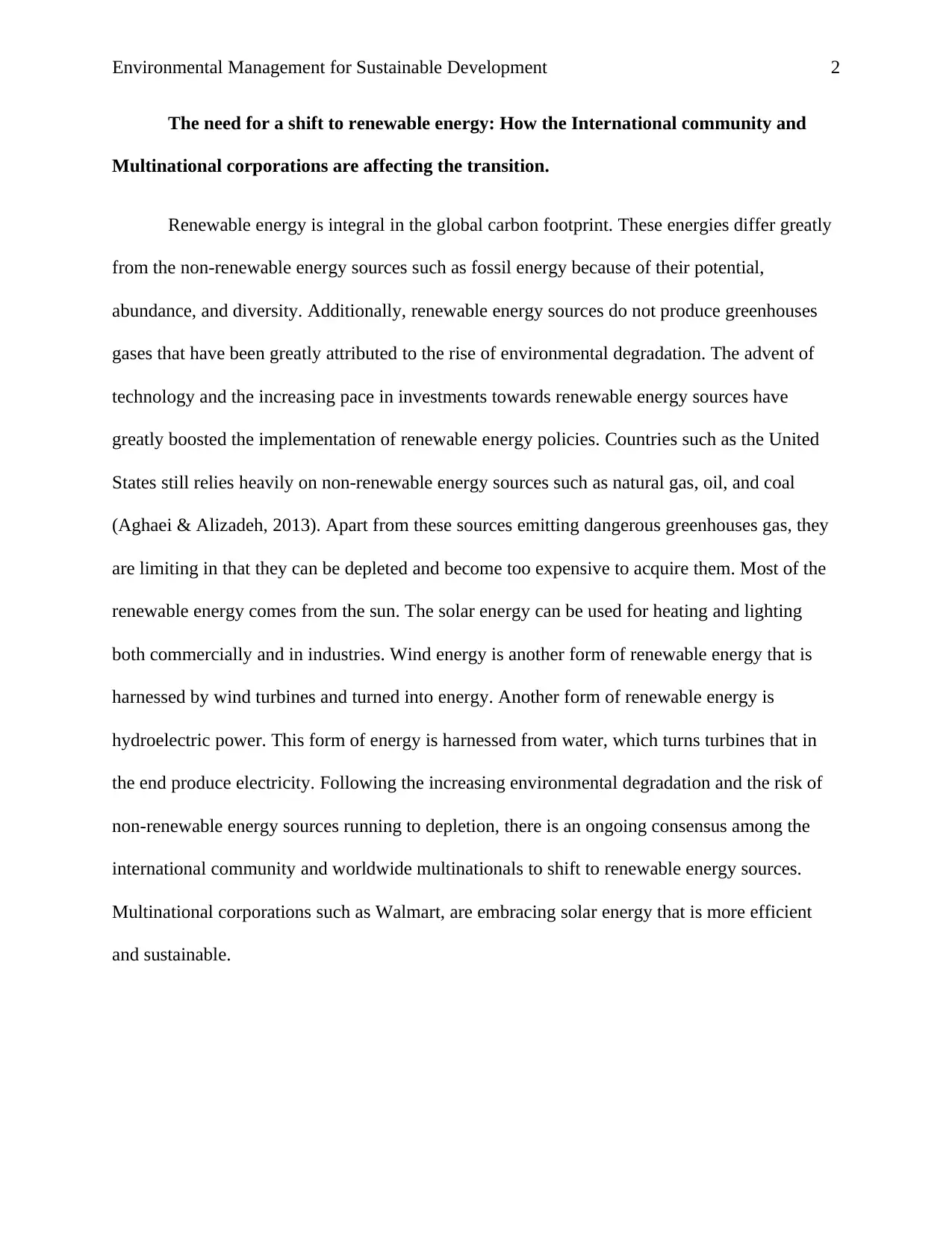
Environmental Management for Sustainable Development 2
The need for a shift to renewable energy: How the International community and
Multinational corporations are affecting the transition.
Renewable energy is integral in the global carbon footprint. These energies differ greatly
from the non-renewable energy sources such as fossil energy because of their potential,
abundance, and diversity. Additionally, renewable energy sources do not produce greenhouses
gases that have been greatly attributed to the rise of environmental degradation. The advent of
technology and the increasing pace in investments towards renewable energy sources have
greatly boosted the implementation of renewable energy policies. Countries such as the United
States still relies heavily on non-renewable energy sources such as natural gas, oil, and coal
(Aghaei & Alizadeh, 2013). Apart from these sources emitting dangerous greenhouses gas, they
are limiting in that they can be depleted and become too expensive to acquire them. Most of the
renewable energy comes from the sun. The solar energy can be used for heating and lighting
both commercially and in industries. Wind energy is another form of renewable energy that is
harnessed by wind turbines and turned into energy. Another form of renewable energy is
hydroelectric power. This form of energy is harnessed from water, which turns turbines that in
the end produce electricity. Following the increasing environmental degradation and the risk of
non-renewable energy sources running to depletion, there is an ongoing consensus among the
international community and worldwide multinationals to shift to renewable energy sources.
Multinational corporations such as Walmart, are embracing solar energy that is more efficient
and sustainable.
The need for a shift to renewable energy: How the International community and
Multinational corporations are affecting the transition.
Renewable energy is integral in the global carbon footprint. These energies differ greatly
from the non-renewable energy sources such as fossil energy because of their potential,
abundance, and diversity. Additionally, renewable energy sources do not produce greenhouses
gases that have been greatly attributed to the rise of environmental degradation. The advent of
technology and the increasing pace in investments towards renewable energy sources have
greatly boosted the implementation of renewable energy policies. Countries such as the United
States still relies heavily on non-renewable energy sources such as natural gas, oil, and coal
(Aghaei & Alizadeh, 2013). Apart from these sources emitting dangerous greenhouses gas, they
are limiting in that they can be depleted and become too expensive to acquire them. Most of the
renewable energy comes from the sun. The solar energy can be used for heating and lighting
both commercially and in industries. Wind energy is another form of renewable energy that is
harnessed by wind turbines and turned into energy. Another form of renewable energy is
hydroelectric power. This form of energy is harnessed from water, which turns turbines that in
the end produce electricity. Following the increasing environmental degradation and the risk of
non-renewable energy sources running to depletion, there is an ongoing consensus among the
international community and worldwide multinationals to shift to renewable energy sources.
Multinational corporations such as Walmart, are embracing solar energy that is more efficient
and sustainable.
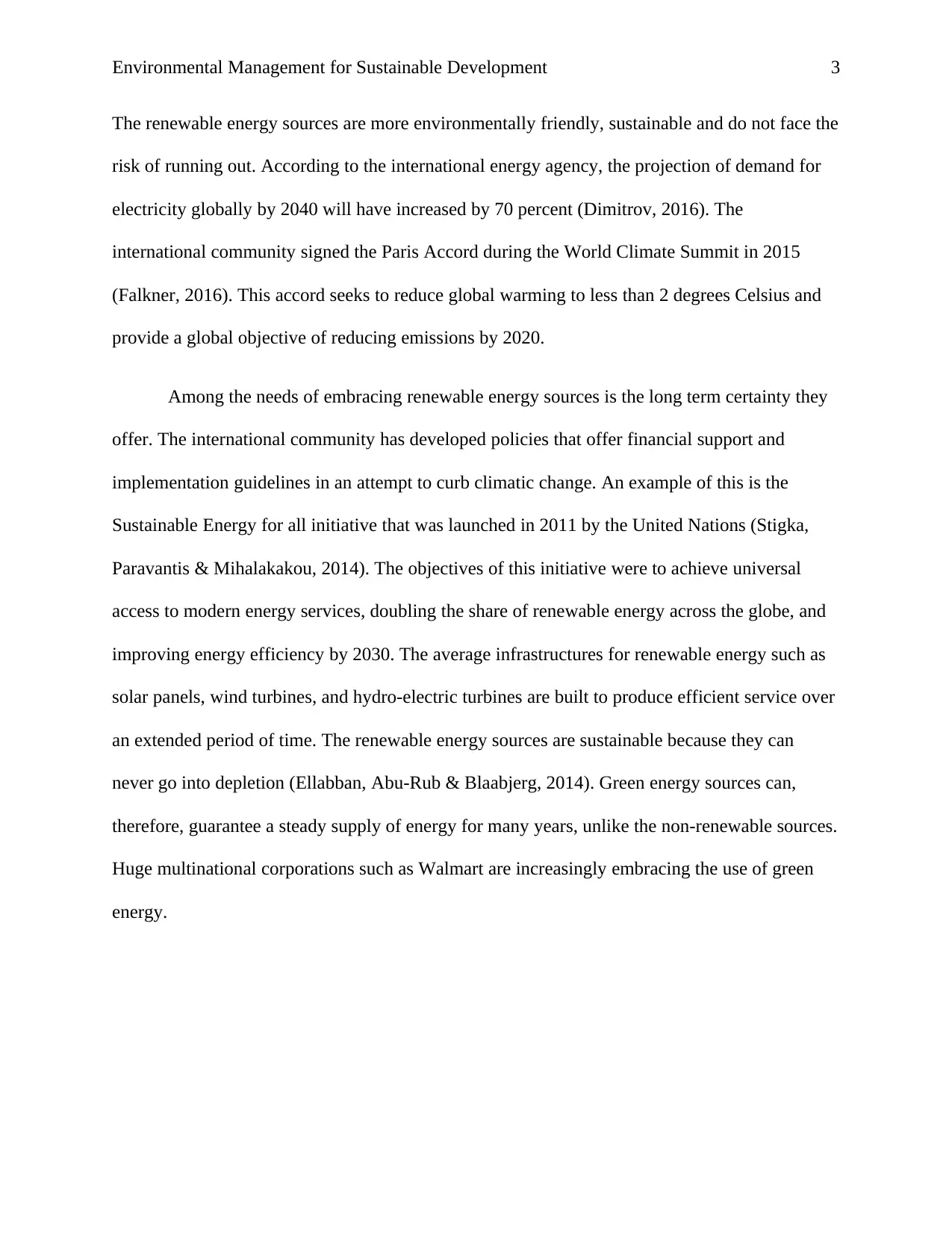
Environmental Management for Sustainable Development 3
The renewable energy sources are more environmentally friendly, sustainable and do not face the
risk of running out. According to the international energy agency, the projection of demand for
electricity globally by 2040 will have increased by 70 percent (Dimitrov, 2016). The
international community signed the Paris Accord during the World Climate Summit in 2015
(Falkner, 2016). This accord seeks to reduce global warming to less than 2 degrees Celsius and
provide a global objective of reducing emissions by 2020.
Among the needs of embracing renewable energy sources is the long term certainty they
offer. The international community has developed policies that offer financial support and
implementation guidelines in an attempt to curb climatic change. An example of this is the
Sustainable Energy for all initiative that was launched in 2011 by the United Nations (Stigka,
Paravantis & Mihalakakou, 2014). The objectives of this initiative were to achieve universal
access to modern energy services, doubling the share of renewable energy across the globe, and
improving energy efficiency by 2030. The average infrastructures for renewable energy such as
solar panels, wind turbines, and hydro-electric turbines are built to produce efficient service over
an extended period of time. The renewable energy sources are sustainable because they can
never go into depletion (Ellabban, Abu-Rub & Blaabjerg, 2014). Green energy sources can,
therefore, guarantee a steady supply of energy for many years, unlike the non-renewable sources.
Huge multinational corporations such as Walmart are increasingly embracing the use of green
energy.
The renewable energy sources are more environmentally friendly, sustainable and do not face the
risk of running out. According to the international energy agency, the projection of demand for
electricity globally by 2040 will have increased by 70 percent (Dimitrov, 2016). The
international community signed the Paris Accord during the World Climate Summit in 2015
(Falkner, 2016). This accord seeks to reduce global warming to less than 2 degrees Celsius and
provide a global objective of reducing emissions by 2020.
Among the needs of embracing renewable energy sources is the long term certainty they
offer. The international community has developed policies that offer financial support and
implementation guidelines in an attempt to curb climatic change. An example of this is the
Sustainable Energy for all initiative that was launched in 2011 by the United Nations (Stigka,
Paravantis & Mihalakakou, 2014). The objectives of this initiative were to achieve universal
access to modern energy services, doubling the share of renewable energy across the globe, and
improving energy efficiency by 2030. The average infrastructures for renewable energy such as
solar panels, wind turbines, and hydro-electric turbines are built to produce efficient service over
an extended period of time. The renewable energy sources are sustainable because they can
never go into depletion (Ellabban, Abu-Rub & Blaabjerg, 2014). Green energy sources can,
therefore, guarantee a steady supply of energy for many years, unlike the non-renewable sources.
Huge multinational corporations such as Walmart are increasingly embracing the use of green
energy.
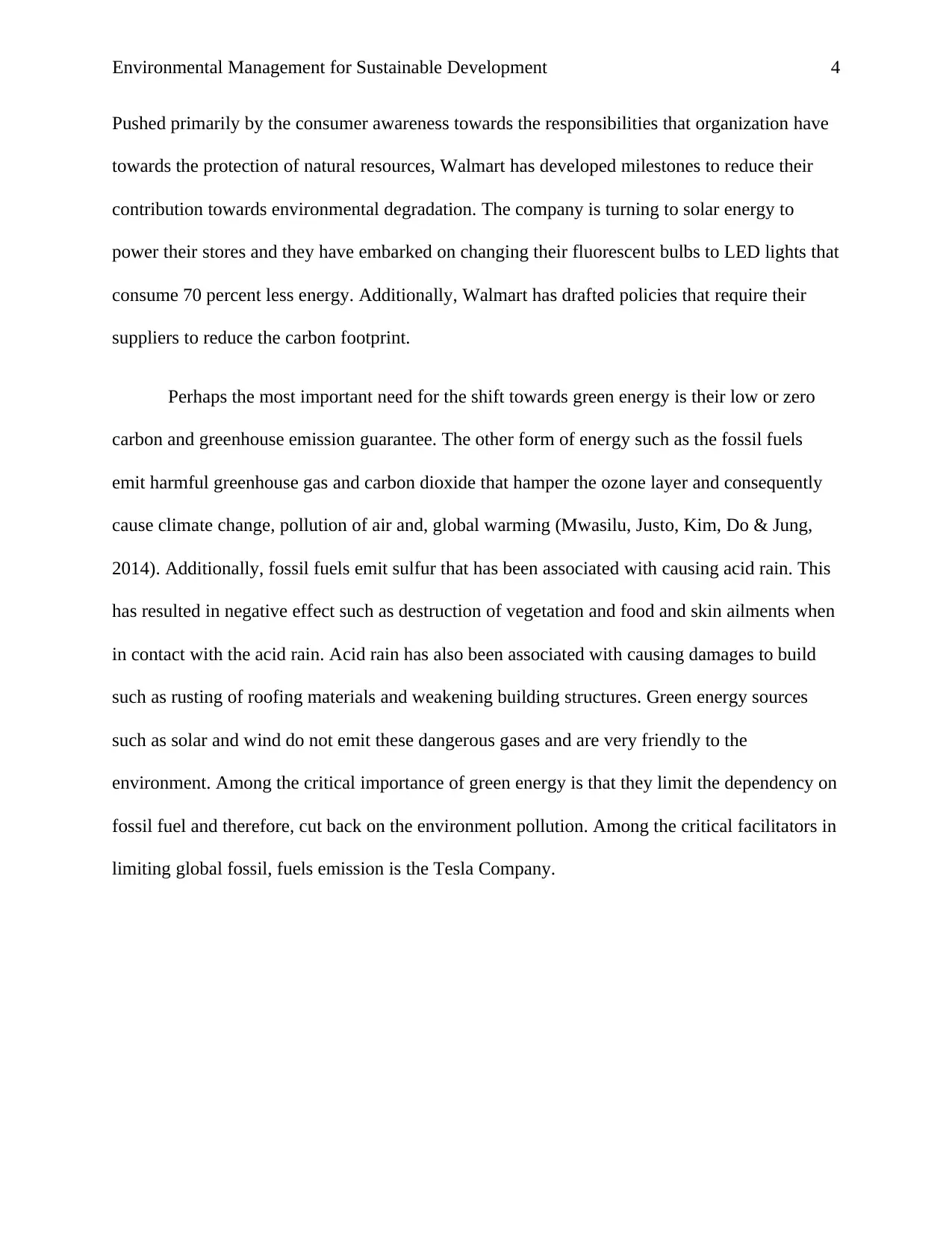
Environmental Management for Sustainable Development 4
Pushed primarily by the consumer awareness towards the responsibilities that organization have
towards the protection of natural resources, Walmart has developed milestones to reduce their
contribution towards environmental degradation. The company is turning to solar energy to
power their stores and they have embarked on changing their fluorescent bulbs to LED lights that
consume 70 percent less energy. Additionally, Walmart has drafted policies that require their
suppliers to reduce the carbon footprint.
Perhaps the most important need for the shift towards green energy is their low or zero
carbon and greenhouse emission guarantee. The other form of energy such as the fossil fuels
emit harmful greenhouse gas and carbon dioxide that hamper the ozone layer and consequently
cause climate change, pollution of air and, global warming (Mwasilu, Justo, Kim, Do & Jung,
2014). Additionally, fossil fuels emit sulfur that has been associated with causing acid rain. This
has resulted in negative effect such as destruction of vegetation and food and skin ailments when
in contact with the acid rain. Acid rain has also been associated with causing damages to build
such as rusting of roofing materials and weakening building structures. Green energy sources
such as solar and wind do not emit these dangerous gases and are very friendly to the
environment. Among the critical importance of green energy is that they limit the dependency on
fossil fuel and therefore, cut back on the environment pollution. Among the critical facilitators in
limiting global fossil, fuels emission is the Tesla Company.
Pushed primarily by the consumer awareness towards the responsibilities that organization have
towards the protection of natural resources, Walmart has developed milestones to reduce their
contribution towards environmental degradation. The company is turning to solar energy to
power their stores and they have embarked on changing their fluorescent bulbs to LED lights that
consume 70 percent less energy. Additionally, Walmart has drafted policies that require their
suppliers to reduce the carbon footprint.
Perhaps the most important need for the shift towards green energy is their low or zero
carbon and greenhouse emission guarantee. The other form of energy such as the fossil fuels
emit harmful greenhouse gas and carbon dioxide that hamper the ozone layer and consequently
cause climate change, pollution of air and, global warming (Mwasilu, Justo, Kim, Do & Jung,
2014). Additionally, fossil fuels emit sulfur that has been associated with causing acid rain. This
has resulted in negative effect such as destruction of vegetation and food and skin ailments when
in contact with the acid rain. Acid rain has also been associated with causing damages to build
such as rusting of roofing materials and weakening building structures. Green energy sources
such as solar and wind do not emit these dangerous gases and are very friendly to the
environment. Among the critical importance of green energy is that they limit the dependency on
fossil fuel and therefore, cut back on the environment pollution. Among the critical facilitators in
limiting global fossil, fuels emission is the Tesla Company.
Secure Best Marks with AI Grader
Need help grading? Try our AI Grader for instant feedback on your assignments.
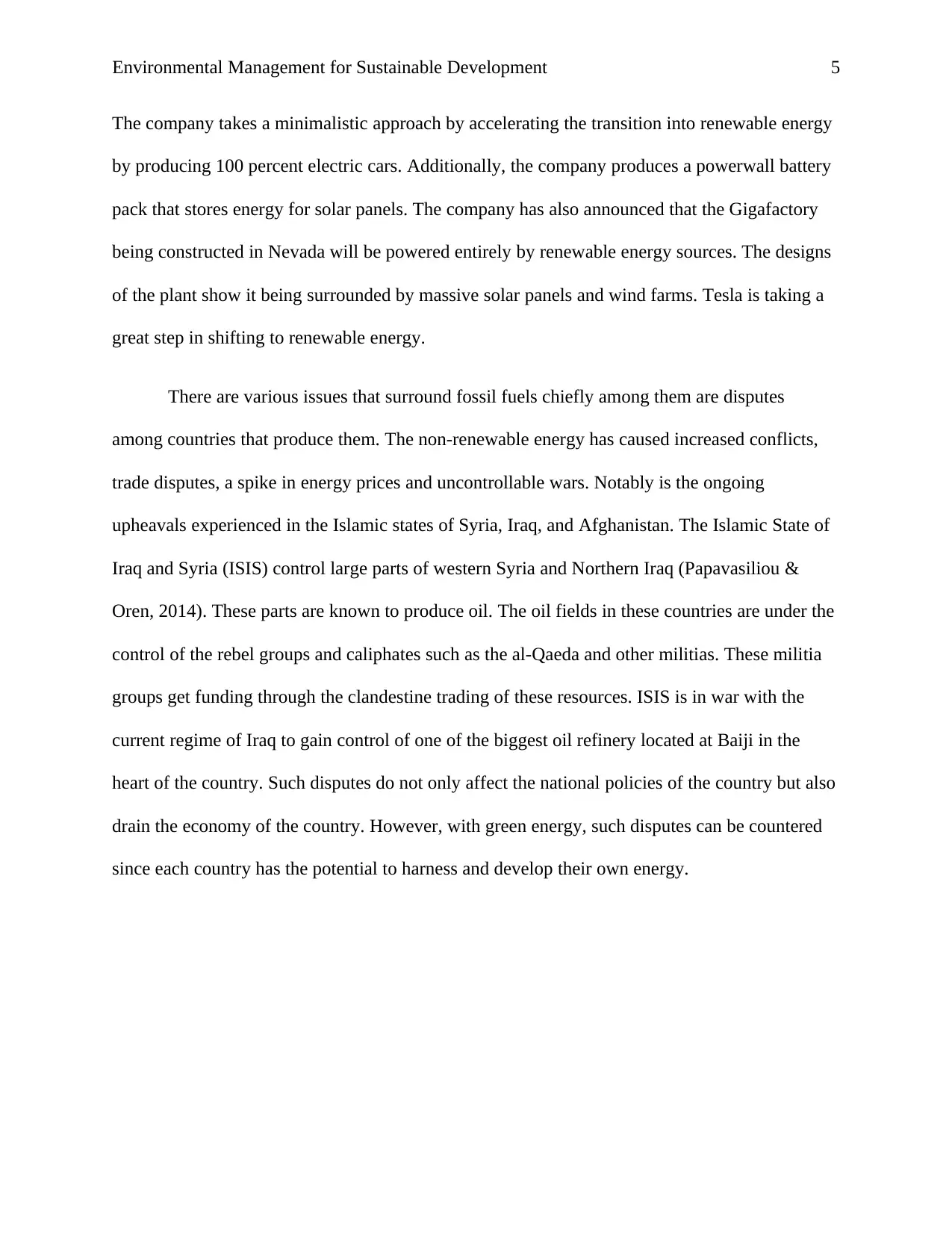
Environmental Management for Sustainable Development 5
The company takes a minimalistic approach by accelerating the transition into renewable energy
by producing 100 percent electric cars. Additionally, the company produces a powerwall battery
pack that stores energy for solar panels. The company has also announced that the Gigafactory
being constructed in Nevada will be powered entirely by renewable energy sources. The designs
of the plant show it being surrounded by massive solar panels and wind farms. Tesla is taking a
great step in shifting to renewable energy.
There are various issues that surround fossil fuels chiefly among them are disputes
among countries that produce them. The non-renewable energy has caused increased conflicts,
trade disputes, a spike in energy prices and uncontrollable wars. Notably is the ongoing
upheavals experienced in the Islamic states of Syria, Iraq, and Afghanistan. The Islamic State of
Iraq and Syria (ISIS) control large parts of western Syria and Northern Iraq (Papavasiliou &
Oren, 2014). These parts are known to produce oil. The oil fields in these countries are under the
control of the rebel groups and caliphates such as the al-Qaeda and other militias. These militia
groups get funding through the clandestine trading of these resources. ISIS is in war with the
current regime of Iraq to gain control of one of the biggest oil refinery located at Baiji in the
heart of the country. Such disputes do not only affect the national policies of the country but also
drain the economy of the country. However, with green energy, such disputes can be countered
since each country has the potential to harness and develop their own energy.
The company takes a minimalistic approach by accelerating the transition into renewable energy
by producing 100 percent electric cars. Additionally, the company produces a powerwall battery
pack that stores energy for solar panels. The company has also announced that the Gigafactory
being constructed in Nevada will be powered entirely by renewable energy sources. The designs
of the plant show it being surrounded by massive solar panels and wind farms. Tesla is taking a
great step in shifting to renewable energy.
There are various issues that surround fossil fuels chiefly among them are disputes
among countries that produce them. The non-renewable energy has caused increased conflicts,
trade disputes, a spike in energy prices and uncontrollable wars. Notably is the ongoing
upheavals experienced in the Islamic states of Syria, Iraq, and Afghanistan. The Islamic State of
Iraq and Syria (ISIS) control large parts of western Syria and Northern Iraq (Papavasiliou &
Oren, 2014). These parts are known to produce oil. The oil fields in these countries are under the
control of the rebel groups and caliphates such as the al-Qaeda and other militias. These militia
groups get funding through the clandestine trading of these resources. ISIS is in war with the
current regime of Iraq to gain control of one of the biggest oil refinery located at Baiji in the
heart of the country. Such disputes do not only affect the national policies of the country but also
drain the economy of the country. However, with green energy, such disputes can be countered
since each country has the potential to harness and develop their own energy.
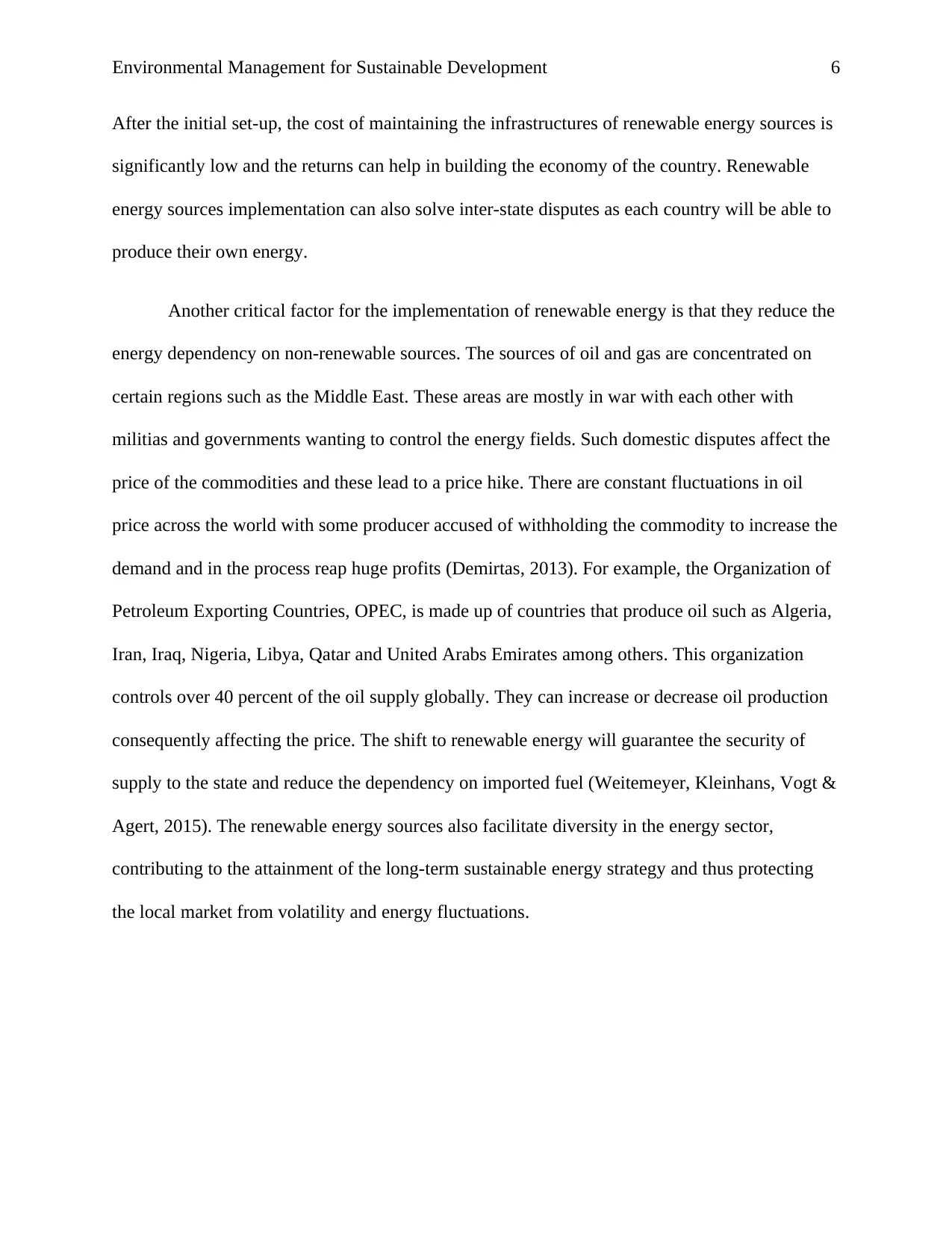
Environmental Management for Sustainable Development 6
After the initial set-up, the cost of maintaining the infrastructures of renewable energy sources is
significantly low and the returns can help in building the economy of the country. Renewable
energy sources implementation can also solve inter-state disputes as each country will be able to
produce their own energy.
Another critical factor for the implementation of renewable energy is that they reduce the
energy dependency on non-renewable sources. The sources of oil and gas are concentrated on
certain regions such as the Middle East. These areas are mostly in war with each other with
militias and governments wanting to control the energy fields. Such domestic disputes affect the
price of the commodities and these lead to a price hike. There are constant fluctuations in oil
price across the world with some producer accused of withholding the commodity to increase the
demand and in the process reap huge profits (Demirtas, 2013). For example, the Organization of
Petroleum Exporting Countries, OPEC, is made up of countries that produce oil such as Algeria,
Iran, Iraq, Nigeria, Libya, Qatar and United Arabs Emirates among others. This organization
controls over 40 percent of the oil supply globally. They can increase or decrease oil production
consequently affecting the price. The shift to renewable energy will guarantee the security of
supply to the state and reduce the dependency on imported fuel (Weitemeyer, Kleinhans, Vogt &
Agert, 2015). The renewable energy sources also facilitate diversity in the energy sector,
contributing to the attainment of the long-term sustainable energy strategy and thus protecting
the local market from volatility and energy fluctuations.
After the initial set-up, the cost of maintaining the infrastructures of renewable energy sources is
significantly low and the returns can help in building the economy of the country. Renewable
energy sources implementation can also solve inter-state disputes as each country will be able to
produce their own energy.
Another critical factor for the implementation of renewable energy is that they reduce the
energy dependency on non-renewable sources. The sources of oil and gas are concentrated on
certain regions such as the Middle East. These areas are mostly in war with each other with
militias and governments wanting to control the energy fields. Such domestic disputes affect the
price of the commodities and these lead to a price hike. There are constant fluctuations in oil
price across the world with some producer accused of withholding the commodity to increase the
demand and in the process reap huge profits (Demirtas, 2013). For example, the Organization of
Petroleum Exporting Countries, OPEC, is made up of countries that produce oil such as Algeria,
Iran, Iraq, Nigeria, Libya, Qatar and United Arabs Emirates among others. This organization
controls over 40 percent of the oil supply globally. They can increase or decrease oil production
consequently affecting the price. The shift to renewable energy will guarantee the security of
supply to the state and reduce the dependency on imported fuel (Weitemeyer, Kleinhans, Vogt &
Agert, 2015). The renewable energy sources also facilitate diversity in the energy sector,
contributing to the attainment of the long-term sustainable energy strategy and thus protecting
the local market from volatility and energy fluctuations.
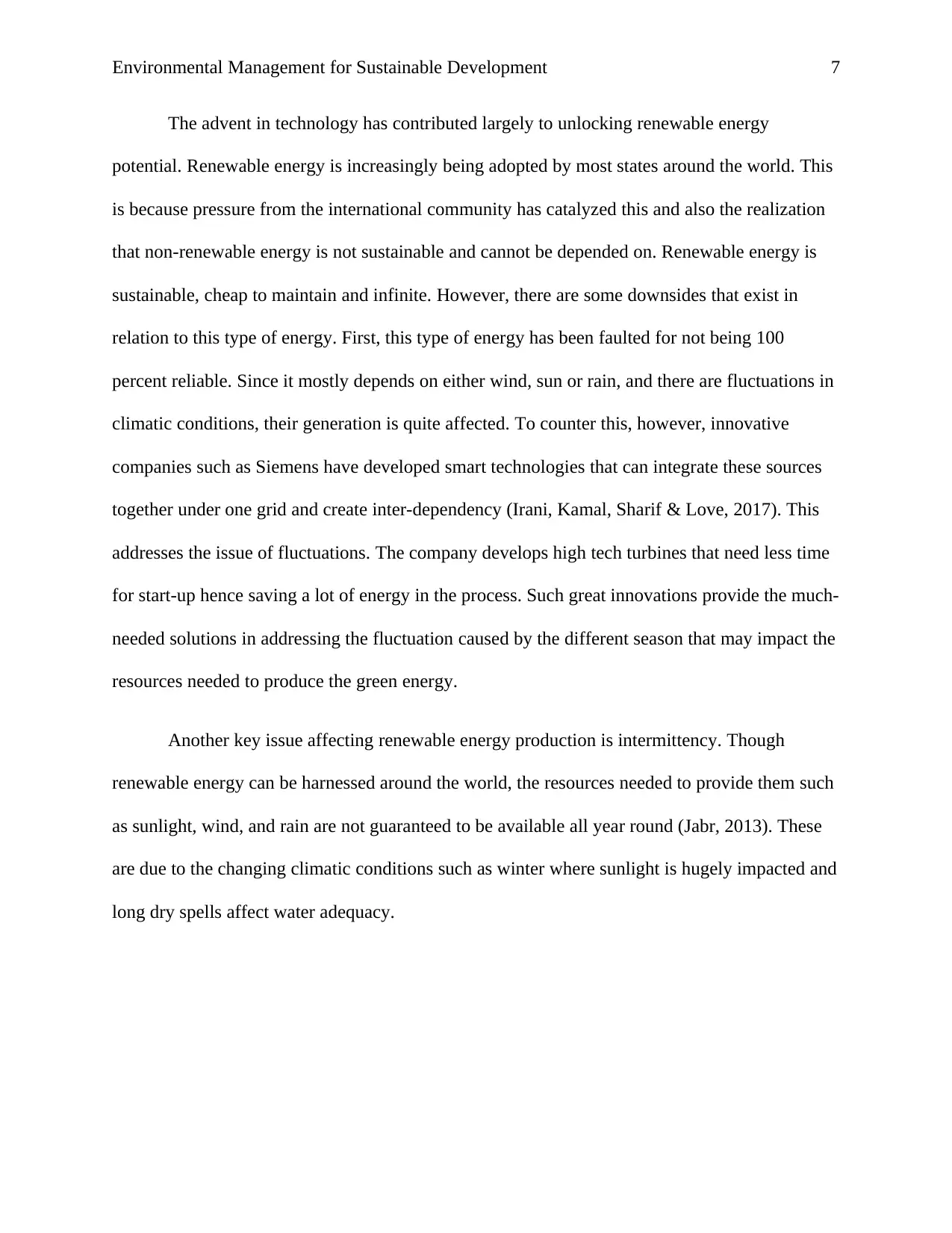
Environmental Management for Sustainable Development 7
The advent in technology has contributed largely to unlocking renewable energy
potential. Renewable energy is increasingly being adopted by most states around the world. This
is because pressure from the international community has catalyzed this and also the realization
that non-renewable energy is not sustainable and cannot be depended on. Renewable energy is
sustainable, cheap to maintain and infinite. However, there are some downsides that exist in
relation to this type of energy. First, this type of energy has been faulted for not being 100
percent reliable. Since it mostly depends on either wind, sun or rain, and there are fluctuations in
climatic conditions, their generation is quite affected. To counter this, however, innovative
companies such as Siemens have developed smart technologies that can integrate these sources
together under one grid and create inter-dependency (Irani, Kamal, Sharif & Love, 2017). This
addresses the issue of fluctuations. The company develops high tech turbines that need less time
for start-up hence saving a lot of energy in the process. Such great innovations provide the much-
needed solutions in addressing the fluctuation caused by the different season that may impact the
resources needed to produce the green energy.
Another key issue affecting renewable energy production is intermittency. Though
renewable energy can be harnessed around the world, the resources needed to provide them such
as sunlight, wind, and rain are not guaranteed to be available all year round (Jabr, 2013). These
are due to the changing climatic conditions such as winter where sunlight is hugely impacted and
long dry spells affect water adequacy.
The advent in technology has contributed largely to unlocking renewable energy
potential. Renewable energy is increasingly being adopted by most states around the world. This
is because pressure from the international community has catalyzed this and also the realization
that non-renewable energy is not sustainable and cannot be depended on. Renewable energy is
sustainable, cheap to maintain and infinite. However, there are some downsides that exist in
relation to this type of energy. First, this type of energy has been faulted for not being 100
percent reliable. Since it mostly depends on either wind, sun or rain, and there are fluctuations in
climatic conditions, their generation is quite affected. To counter this, however, innovative
companies such as Siemens have developed smart technologies that can integrate these sources
together under one grid and create inter-dependency (Irani, Kamal, Sharif & Love, 2017). This
addresses the issue of fluctuations. The company develops high tech turbines that need less time
for start-up hence saving a lot of energy in the process. Such great innovations provide the much-
needed solutions in addressing the fluctuation caused by the different season that may impact the
resources needed to produce the green energy.
Another key issue affecting renewable energy production is intermittency. Though
renewable energy can be harnessed around the world, the resources needed to provide them such
as sunlight, wind, and rain are not guaranteed to be available all year round (Jabr, 2013). These
are due to the changing climatic conditions such as winter where sunlight is hugely impacted and
long dry spells affect water adequacy.
Paraphrase This Document
Need a fresh take? Get an instant paraphrase of this document with our AI Paraphraser
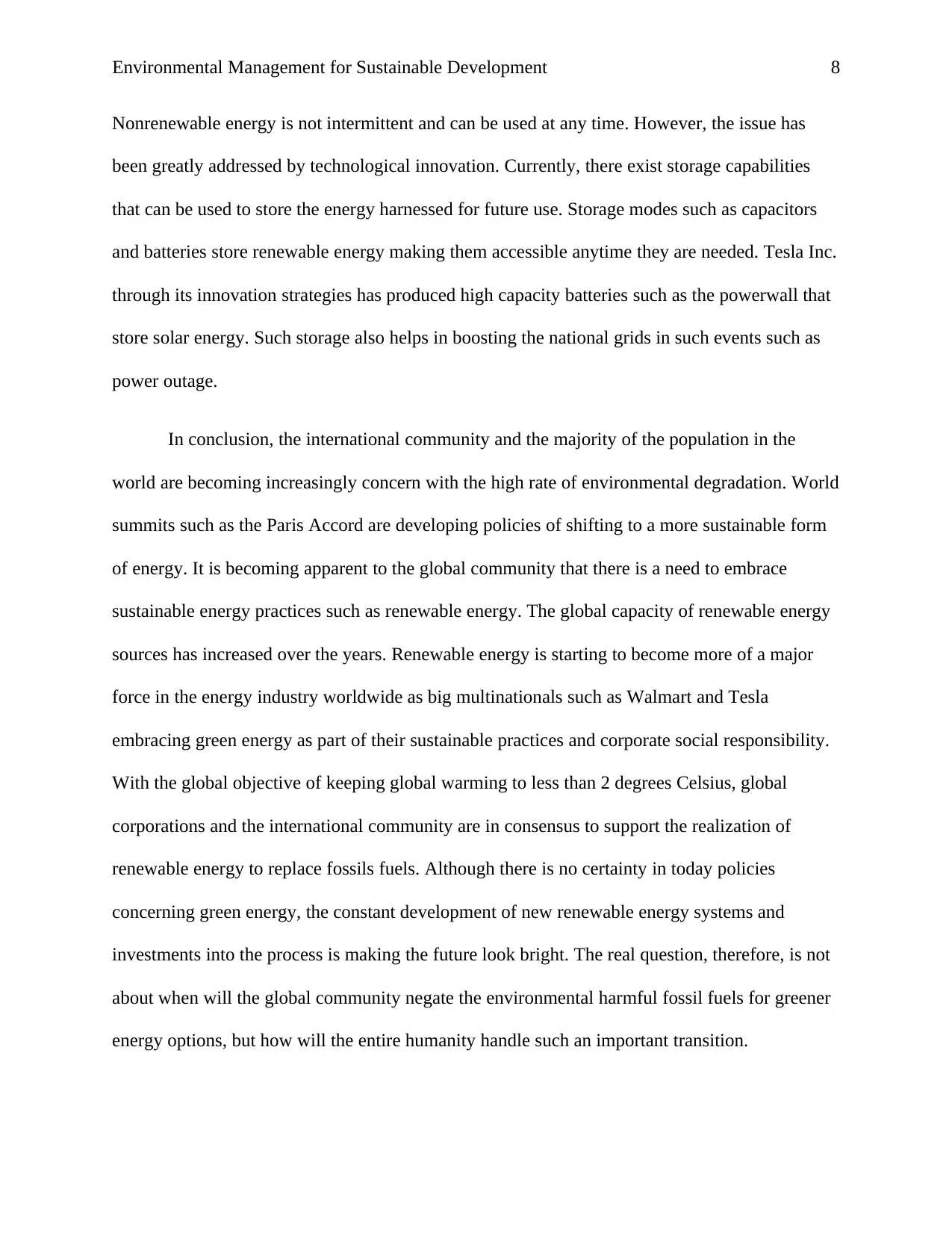
Environmental Management for Sustainable Development 8
Nonrenewable energy is not intermittent and can be used at any time. However, the issue has
been greatly addressed by technological innovation. Currently, there exist storage capabilities
that can be used to store the energy harnessed for future use. Storage modes such as capacitors
and batteries store renewable energy making them accessible anytime they are needed. Tesla Inc.
through its innovation strategies has produced high capacity batteries such as the powerwall that
store solar energy. Such storage also helps in boosting the national grids in such events such as
power outage.
In conclusion, the international community and the majority of the population in the
world are becoming increasingly concern with the high rate of environmental degradation. World
summits such as the Paris Accord are developing policies of shifting to a more sustainable form
of energy. It is becoming apparent to the global community that there is a need to embrace
sustainable energy practices such as renewable energy. The global capacity of renewable energy
sources has increased over the years. Renewable energy is starting to become more of a major
force in the energy industry worldwide as big multinationals such as Walmart and Tesla
embracing green energy as part of their sustainable practices and corporate social responsibility.
With the global objective of keeping global warming to less than 2 degrees Celsius, global
corporations and the international community are in consensus to support the realization of
renewable energy to replace fossils fuels. Although there is no certainty in today policies
concerning green energy, the constant development of new renewable energy systems and
investments into the process is making the future look bright. The real question, therefore, is not
about when will the global community negate the environmental harmful fossil fuels for greener
energy options, but how will the entire humanity handle such an important transition.
Nonrenewable energy is not intermittent and can be used at any time. However, the issue has
been greatly addressed by technological innovation. Currently, there exist storage capabilities
that can be used to store the energy harnessed for future use. Storage modes such as capacitors
and batteries store renewable energy making them accessible anytime they are needed. Tesla Inc.
through its innovation strategies has produced high capacity batteries such as the powerwall that
store solar energy. Such storage also helps in boosting the national grids in such events such as
power outage.
In conclusion, the international community and the majority of the population in the
world are becoming increasingly concern with the high rate of environmental degradation. World
summits such as the Paris Accord are developing policies of shifting to a more sustainable form
of energy. It is becoming apparent to the global community that there is a need to embrace
sustainable energy practices such as renewable energy. The global capacity of renewable energy
sources has increased over the years. Renewable energy is starting to become more of a major
force in the energy industry worldwide as big multinationals such as Walmart and Tesla
embracing green energy as part of their sustainable practices and corporate social responsibility.
With the global objective of keeping global warming to less than 2 degrees Celsius, global
corporations and the international community are in consensus to support the realization of
renewable energy to replace fossils fuels. Although there is no certainty in today policies
concerning green energy, the constant development of new renewable energy systems and
investments into the process is making the future look bright. The real question, therefore, is not
about when will the global community negate the environmental harmful fossil fuels for greener
energy options, but how will the entire humanity handle such an important transition.
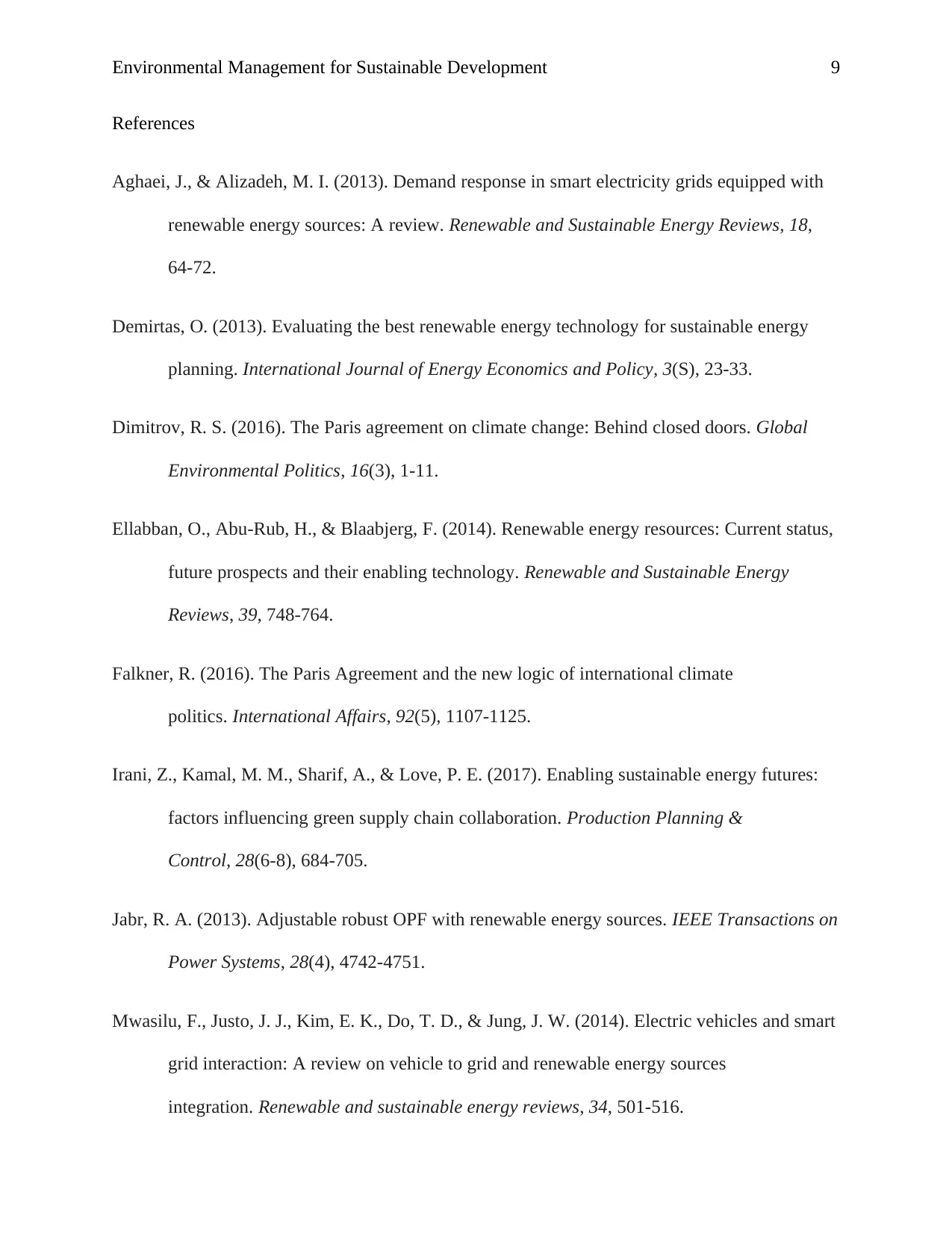
Environmental Management for Sustainable Development 9
References
Aghaei, J., & Alizadeh, M. I. (2013). Demand response in smart electricity grids equipped with
renewable energy sources: A review. Renewable and Sustainable Energy Reviews, 18,
64-72.
Demirtas, O. (2013). Evaluating the best renewable energy technology for sustainable energy
planning. International Journal of Energy Economics and Policy, 3(S), 23-33.
Dimitrov, R. S. (2016). The Paris agreement on climate change: Behind closed doors. Global
Environmental Politics, 16(3), 1-11.
Ellabban, O., Abu-Rub, H., & Blaabjerg, F. (2014). Renewable energy resources: Current status,
future prospects and their enabling technology. Renewable and Sustainable Energy
Reviews, 39, 748-764.
Falkner, R. (2016). The Paris Agreement and the new logic of international climate
politics. International Affairs, 92(5), 1107-1125.
Irani, Z., Kamal, M. M., Sharif, A., & Love, P. E. (2017). Enabling sustainable energy futures:
factors influencing green supply chain collaboration. Production Planning &
Control, 28(6-8), 684-705.
Jabr, R. A. (2013). Adjustable robust OPF with renewable energy sources. IEEE Transactions on
Power Systems, 28(4), 4742-4751.
Mwasilu, F., Justo, J. J., Kim, E. K., Do, T. D., & Jung, J. W. (2014). Electric vehicles and smart
grid interaction: A review on vehicle to grid and renewable energy sources
integration. Renewable and sustainable energy reviews, 34, 501-516.
References
Aghaei, J., & Alizadeh, M. I. (2013). Demand response in smart electricity grids equipped with
renewable energy sources: A review. Renewable and Sustainable Energy Reviews, 18,
64-72.
Demirtas, O. (2013). Evaluating the best renewable energy technology for sustainable energy
planning. International Journal of Energy Economics and Policy, 3(S), 23-33.
Dimitrov, R. S. (2016). The Paris agreement on climate change: Behind closed doors. Global
Environmental Politics, 16(3), 1-11.
Ellabban, O., Abu-Rub, H., & Blaabjerg, F. (2014). Renewable energy resources: Current status,
future prospects and their enabling technology. Renewable and Sustainable Energy
Reviews, 39, 748-764.
Falkner, R. (2016). The Paris Agreement and the new logic of international climate
politics. International Affairs, 92(5), 1107-1125.
Irani, Z., Kamal, M. M., Sharif, A., & Love, P. E. (2017). Enabling sustainable energy futures:
factors influencing green supply chain collaboration. Production Planning &
Control, 28(6-8), 684-705.
Jabr, R. A. (2013). Adjustable robust OPF with renewable energy sources. IEEE Transactions on
Power Systems, 28(4), 4742-4751.
Mwasilu, F., Justo, J. J., Kim, E. K., Do, T. D., & Jung, J. W. (2014). Electric vehicles and smart
grid interaction: A review on vehicle to grid and renewable energy sources
integration. Renewable and sustainable energy reviews, 34, 501-516.
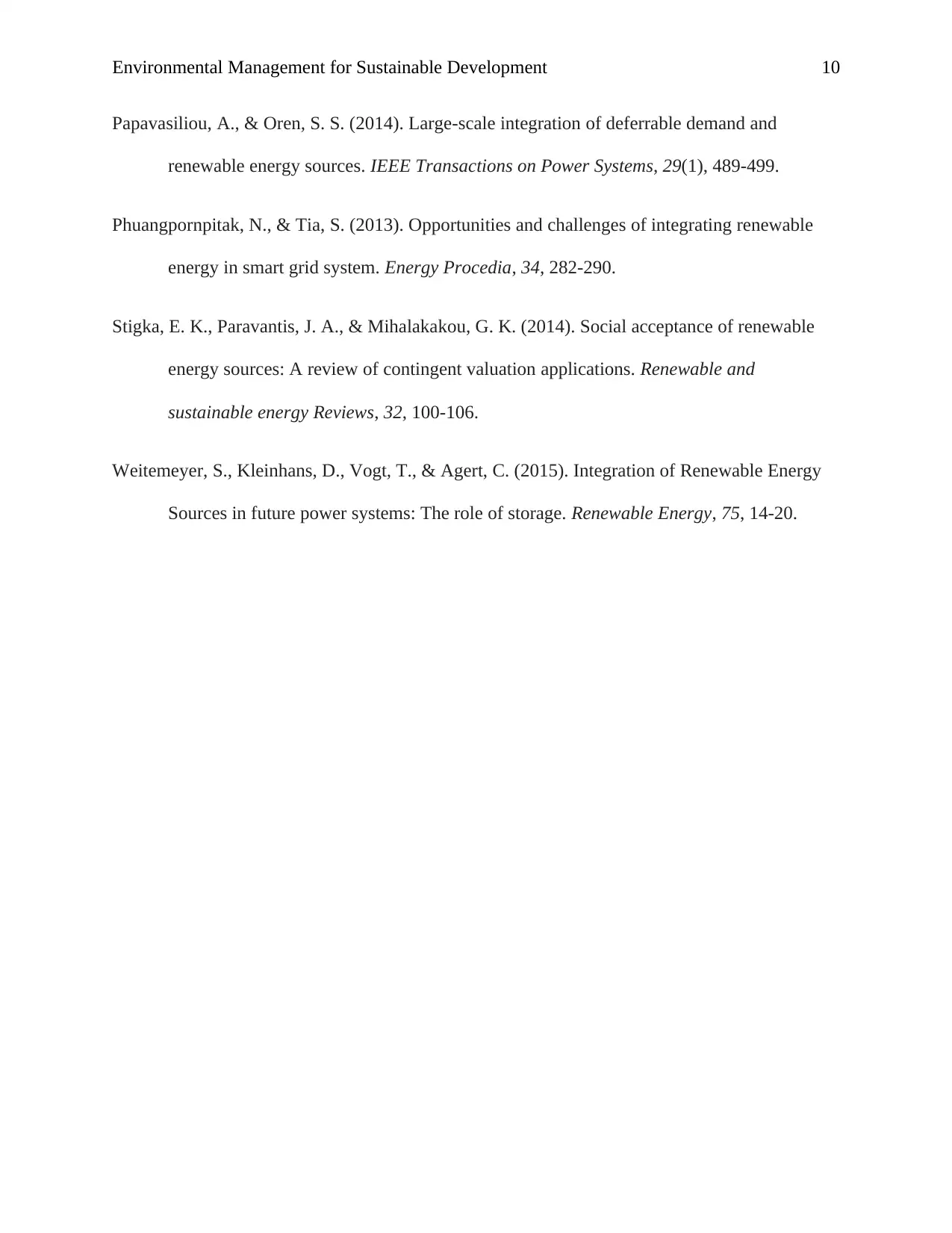
Environmental Management for Sustainable Development 10
Papavasiliou, A., & Oren, S. S. (2014). Large-scale integration of deferrable demand and
renewable energy sources. IEEE Transactions on Power Systems, 29(1), 489-499.
Phuangpornpitak, N., & Tia, S. (2013). Opportunities and challenges of integrating renewable
energy in smart grid system. Energy Procedia, 34, 282-290.
Stigka, E. K., Paravantis, J. A., & Mihalakakou, G. K. (2014). Social acceptance of renewable
energy sources: A review of contingent valuation applications. Renewable and
sustainable energy Reviews, 32, 100-106.
Weitemeyer, S., Kleinhans, D., Vogt, T., & Agert, C. (2015). Integration of Renewable Energy
Sources in future power systems: The role of storage. Renewable Energy, 75, 14-20.
Papavasiliou, A., & Oren, S. S. (2014). Large-scale integration of deferrable demand and
renewable energy sources. IEEE Transactions on Power Systems, 29(1), 489-499.
Phuangpornpitak, N., & Tia, S. (2013). Opportunities and challenges of integrating renewable
energy in smart grid system. Energy Procedia, 34, 282-290.
Stigka, E. K., Paravantis, J. A., & Mihalakakou, G. K. (2014). Social acceptance of renewable
energy sources: A review of contingent valuation applications. Renewable and
sustainable energy Reviews, 32, 100-106.
Weitemeyer, S., Kleinhans, D., Vogt, T., & Agert, C. (2015). Integration of Renewable Energy
Sources in future power systems: The role of storage. Renewable Energy, 75, 14-20.
1 out of 10
Related Documents
Your All-in-One AI-Powered Toolkit for Academic Success.
+13062052269
info@desklib.com
Available 24*7 on WhatsApp / Email
![[object Object]](/_next/static/media/star-bottom.7253800d.svg)
Unlock your academic potential
© 2024 | Zucol Services PVT LTD | All rights reserved.





